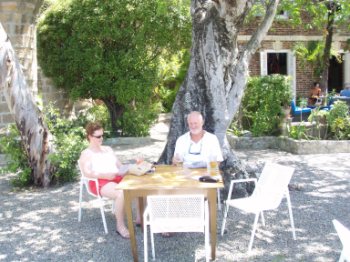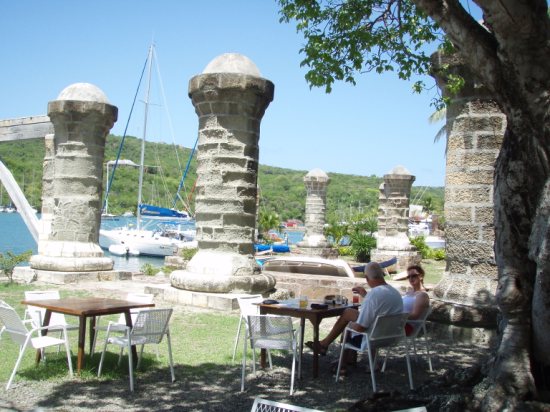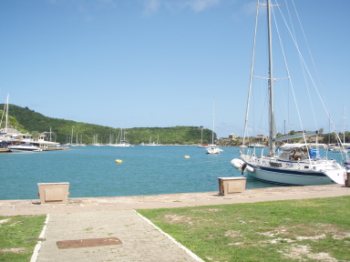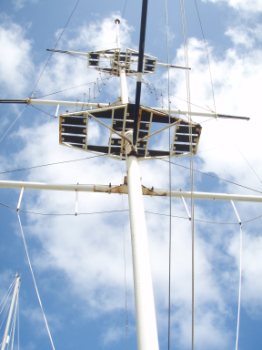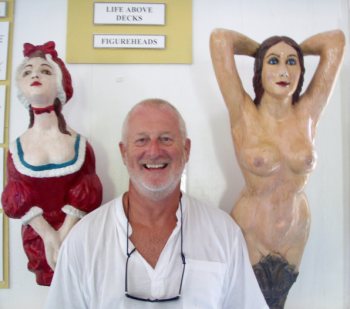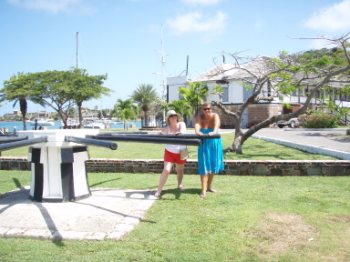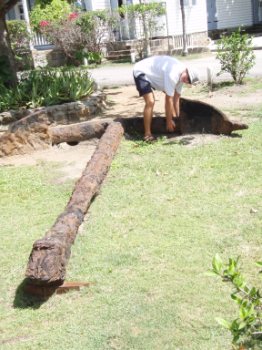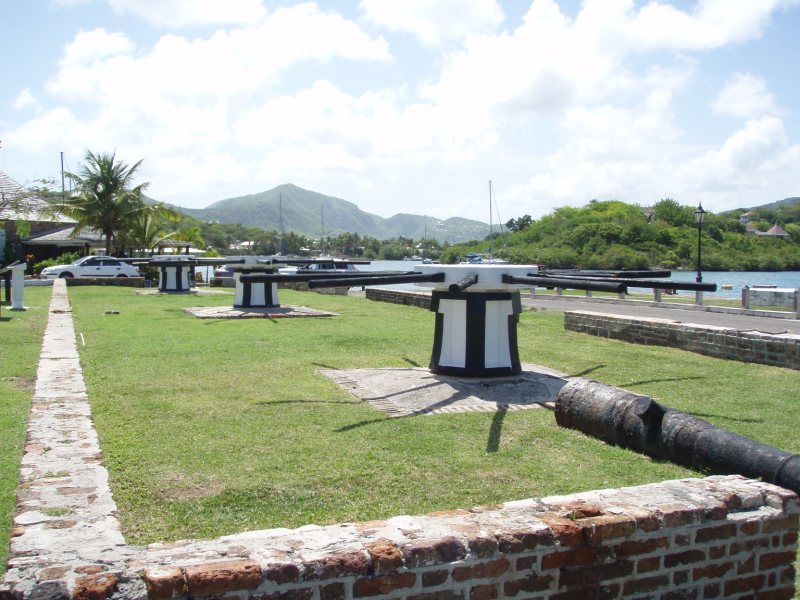Nelson's Dockyard

|
Nelson's
Dockyard
We had a leisurely start to Sunday, cooked brunch and a slow drive down to English Harbour via Falmouth Harbour.
For nearly a hundred years, starting from 1713, the Caribbean was the scene of struggle for naval supremacy in which Britain, Spain, Portugal, France and the United States were competitors. In this power contest of the 18th century, Britain's strength lay in her Navy and the waters around the valued sugar and spice islands of the Caribbean. Privateers were at large in the Caribbean anxious to seize the valuable cargoes of sugar and other products being sent from the West Indies to Europe. And this confused situation was still further complicated by the American War of Independence and the attempts of Britain in the last quarter of the 18th century to restrict trade with her former American Colonies. It is against this background of world unrest and competition that English Harbour was developed into Britain's main naval base in the Eastern Caribbean. English Harbour's importance grew in the 18th century, not only as a port but also as a hurricane refuge and for careening His Majesty's Ships in the deep water against the shore. By being able to repair, victual and water ships in the West Indies, Britain was able to keep a squadron of ships continually in the Caribbean, thus maintaining naval superiority over the enemy. Well known British admirals who used the harbour were Rodney, Hood, Nelson and Lewis. The name Nelson's Dockyard has been derived from the fact that Captain Nelson was made temporary Commander of the Leeward Islands Station ( 1784 - 1787 ).
We arrived and paid the $5 entry and made our way to the Admiral's Inn Hotel and Restaurant for a beer and to read our leaflets, this building used to be the Pitch and Tar Store and Engineer's Office. The restored pillars are called The Boat House Pillars. Behind them was the Sick House which is now the annexe to the Admiral's Inn.
Captain later Lord Nelson on H.M.S. Boreas, tried during his tenure, to strictly enforce the Navigation Acts. These acts prohibited trade with the newly formed United States of America. Most of the merchants in Antigua depended upon American trade, so many of them despised Captain Nelson. As a result, he was unable to get a promotion for some time after his stint on the island. Conversely, the British considered Nelson a hero. The following quote from The Life of Horatio Lord Nelson by Robert Southey sums up his views about the controversial Navigation Acts: The Americans were at this time trading with our islands, taking advantage of the register of their ships, which had been issued while they were British subjects. Nelson knew that, by the Navigation Act, no foreigners, directly or indirectly, are permitted to carry on any trade with these possessions. He knew, also, that the Americans had made themselves foreigners with regard to England; they had disregarded the ties of blood and language when they acquired the independence which they had been led on to claim, unhappily for themselves before they were fit for it; and he was resolved that they should derive no profit from those ties now. Foreigners they had made themselves, and as foreigners they were to be treated.
Southey then quotes Nelson as saying that "( The Antiguan Colonists ) are as great rebels as ever were in America, had they the power to show it."
References to English Harbour as a hurricane haven for ships can be traced as far back as 1671, and the British began to use it as a Naval Dockyard in 1725 when St. Helena, located on the eastern side of the harbour, was allocated funds for construction. The next major change occurred following 1743 when Commodore Charles Knowles established the Dockyard at its site and developed it extensively. A survey of 1774 outlined the present layout and most of the buildings seen today were built between 1785 and 1792. Steam powered ships and waning interest in the area caused the Dockyard to fall into gradual disuse until the Royal Navy completely closed it in 1889. The Friends of English Harbour, formed in 1951, reconstructed the Dockyard and officially reopened it in 1961 after much restoration work. Now this Georgian Naval Dockyard is part of Antigua and Barbuda National Parks Authority. Today this historic maritime monument provides one of the best examples of adaptive use found in the Caribbean. This means that the harbour and many of the buildings are being used in ways that approximate the purpose for which they were built. Instead of the old naval vessels, the harbour is used by private sailing yachts. Many of the buildings help service yachts that are based here, and those that are making ocean voyages. History has come round in full circle. With tourism now providing Antigua with a major source of revenue and employment, the Dockyard Authorities have taken on a new dimension. This is to further the creation of jobs for Antigua's youth through traditional and craft skills, and maritime activities. Revenue producing enterprises with Antiguan ownership are also being developed.
Admiral's House. Commissioner's Room and Pay Office. The Officer's Quarters.
Buildings of particular interest.
The Admiral's House: Built in 1855, the Admiral's House, with it venerable wooden bust of Nelson above the entrance, was originally constructed as a residence for the Naval Officer in charge and the Storekeeper. In fact, this house has never accommodated an Admiral. The ground floor and upper floor is a museum with many interesting articles significant to the historical development of the Dockyard. Also located here the entrance to the left, is the restoration gift shop, in it you will find souvenirs reflective of the Dockyard plus a few tacky plastic pirate bits and bobs. Beside the house is a Sandbox tree over 200 years old, whose pods were used to hold sand, which substituted for blotting paper on Gentlemen's desks. Behind the Admiral's House can be found the old stone kitchen. The ancient ovens were used on festive occasions until recently by the people of English Harbour. Here you will see the bakers busy at work producing their oven fresh pastries. The pineapple turnovers are irresistible, pan bread is delicious.
Time in the museum for Bear and Jump to get acquainted with a figurehead and some soldiers. Bear you are a captain NOT an admiral. There's time
Bear also got VERY acquainted with Amanda Fenwick on the left - busty Britannia on the right. Bare breasts shame the stormy sea, (I cannot print one of the pictures of his acquainting - but I can be paid to show it).
The Copper and Lumber Store: with great care has been converted into a hotel with 14 self catering apartments, and a restaurant. This beautiful example of Georgian architecture contains a unique arched courtyard, a convivial atmosphere for a pause and a step back in time.
The Officer's Quarters Building: is built on an enormous water system with a capacity of 450 tons. In this building, officers from the ships lived during the hurricane months. Climbing the stairs you can find a number of interesting activities going on. There is an art gallery with local paintings and also a picture framing shop. To the far end of the building is a pharmacy. The Limey's Restaurant is also on this level.
The Capstan House: the low wall marks where the old capstan house stood, the capstans have been restored, this is were the ships were hoved for careening to work on the bottoms of the ships. Bear trying to slip away with an anchor. Even the toilets have been renovated.
ALL IN ALL A VERY PLEASANT WAY TO SPEND A FEW HOURS AND STEP BACK IN TIME.
|
